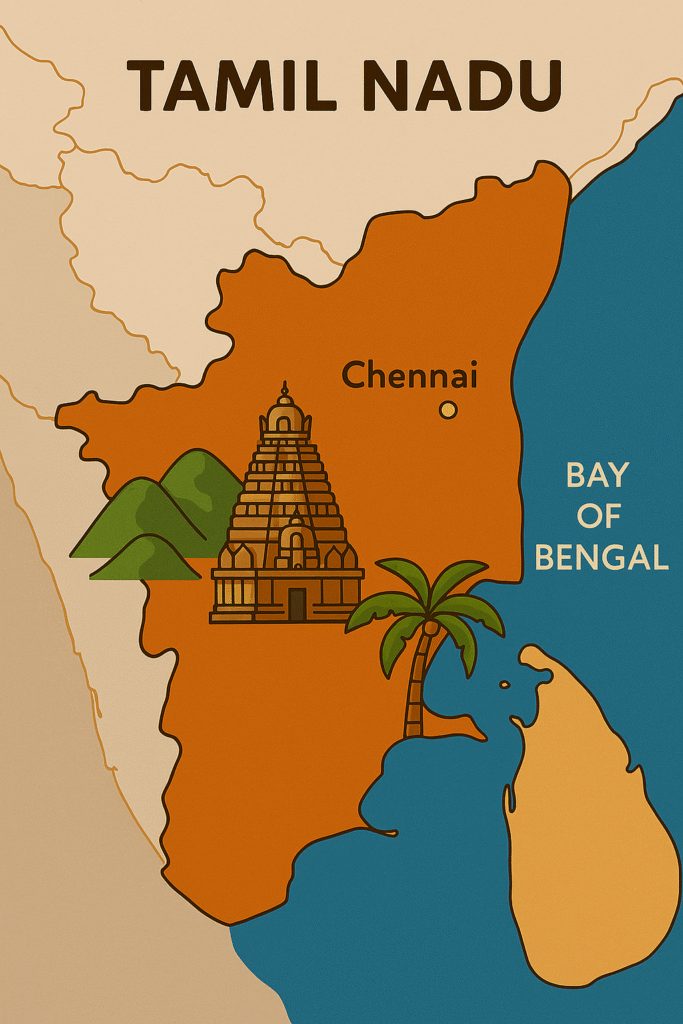
Tamil Nadu is a major state located in the southern part of India , famous for its rich cultural heritage , historical heritage and natural beauty. The state is located on the coast of the Bay of Bengal and its capital is Chennai ( formerly Madras ) . Tamil Nadu has an area of about 1,30,058 square kilometers , and it is one of the major industrial and cultural centers of the country.
Geographical location
- is bordered by Karnataka and Andhra Pradesh to the north , Kerala to the west and the Indian Ocean to the south.
- To the east lies the Bay of Bengal , making it a major coastal state.
- the Nilgiris , Annamalai , and Western Ghats provide it with natural beauty.
History
The history of Tamil Nadu is linked to the ancient Dravidian civilization. It has been the center of the Chola , Pandya , and Chera empires , which made incomparable contributions to architecture , art, and literature. The many historic temples in the state , such as the Brihadeeswarar Temple in Thanjavur and the Meenakshi Temple in Madurai , bear testimony to this glorious history.
Language and culture
- Language : Tamil , one of the oldest languages in the world and has the status of a classical language.
- Music and Dance : Tamil Nadu is a major centre for Bharatanatyam , Carnatic music and traditional folk arts.
- Festivals : Festivals like Pongal , Diwali , and Tamil New Year are celebrated here with great pomp.
economy
The economy of Tamil Nadu is primarily based on agriculture , industry , and services.
- Agriculture : Rice , coconut , and sugarcane are the major crops.
- Industries : Automobile , textile , and IT industries are the backbone of the state.
- Tourism : The state has many beaches , hill stations ( Ooty , Kodaikanal ), and temples making it attractive for tourism.
major city
- Chennai : Industrial and educational hub.
- Coimbatore : Textile Hub.
- Madurai : City of Temples.
- Tiruchirapalli ( Trichy ) : Historical and religious places.
Tourism
Major attractions of Tamil Nadu :
- Meenakshi Temple , Madurai
- Group of Monuments at Mahabalipuram
- kanyakumari
- Hill Stations of Ooty and Kodaikanal
- Rameswaram
conclusion
Tamil Nadu is a state of India that presents a wonderful amalgamation of modernity and antiquity. Its rich culture , historical sites and natural wealth make it one of the most special states of India.
Geographical location

The geographical location of Tamil Nadu makes it naturally diverse and rich. This state is located in the southern part of India and its various regions are particularly noteworthy from the geographical point of view. Let us understand this in detail :
Status and limitations
- Location : The latitudinal extent of Tamil Nadu is from 8°5′ North to 13°35′ North and longitude from 76°15′ East to 80°20′ East.
- boundaries :
- Answer : Karnataka and Andhra Pradesh.
- West : Kerala.
- South : Indian Ocean.
- East : Bay of Bengal.
- Coastline : Tamil Nadu has a coastline of about 1,076 km , making it one of the major coastal states of India. This coastal area is extremely important for fisheries and maritime trade.
geographical feature
1. Mountainous region
Several important mountain ranges and hills are located in Tamil Nadu :
- Western Ghats :
- The Nilgiri and Annamalai Hills are prominent here.
- Ooty ( Udhagamandalam ) is a major tourist destination in the Nilgiri Hills.
- Eastern Ghats :
- These hills are located near the border of Andhra Pradesh and Tamil Nadu.
- Many waterfalls and streams are found in the hills of the Eastern Ghats.
- Shevaroy and Kodaikanal Hills :
- Kodaikanal hill station is famous for its serene atmosphere and greenery.
2. Plains
- A large part of Tamil Nadu is covered by fertile plains created by rivers.
- Cauvery Delta :
- The region around the Kaveri River is extremely fertile and is called the ” Rice Bowl of South India ” .
- Major agricultural activities are carried out in the plains , and they contribute significantly to the economy of the state.
3. Rivers
The major rivers in Tamil Nadu play an important role in the state’s agriculture and water supply :
- Cauvery River : Considered the lifeline of the state.
- Vaigai River : Source of water supply for Madurai and surrounding areas.
- Tamiraparani River : Major river in southern Tamil Nadu.
- Other rivers : Panniyar , Pala and Cheyyar.
However most rivers in Tamil Nadu are rain – fed and depend on the monsoon.
4. Coastal area
- The eastern coastline of Tamil Nadu borders the Bay of Bengal.
- The area is a centre for maritime trade , fisheries , and tourist attraction.
- Marina Beach ( Chennai ) and Mahabalipuram Places such as these are typical of the coastal region.
5. Climate
The climate of Tamil Nadu is tropical :
- Summer : Temperature ranges from 25°C to 45°C .
- Winter : Temperature ranges from 20°C to 30°C .
- Monsoon : There are two monsoons in the state –
- South – west monsoon ( June to September ) .
- The north – east monsoon ( October to December ), which brings most of the rain to the state.
6. Forests and wildlife
- The forests of the Western Ghats and the semi – arid areas of the Eastern Ghats in Tamil Nadu are famous for their biodiversity.
- Major National Parks :
- Mudumalai National Park .
- Indira Gandhi Wildlife Sanctuary .
- Gundi National Park .
- Elephants , tigers , deer and many rare species of birds are found here.
7. Island area
- Pamban Island : It is part of the Rameswaram and Dhanushkodi area.
- From here the Indomitable Bridge ( Ram Sethu ) of Sri Lanka is visible in the sea.
Important Geographic Facts
- Doddabetta Peak is the highest point in Tamil Nadu , which is situated in the Nilgiri Hills.
- The state is rich in rivers and lakes , which help it deal with water crisis.
- The beaches and mountain areas make it attractive for tourists and environment lovers.
conclusion
Tamil Nadu’s geographical location makes it naturally diverse. Its mountains , plains , coastline , and climate not only enrich its economic and cultural heritage but also make it an important tourist destination and agricultural center.
History of Tamil Nadu
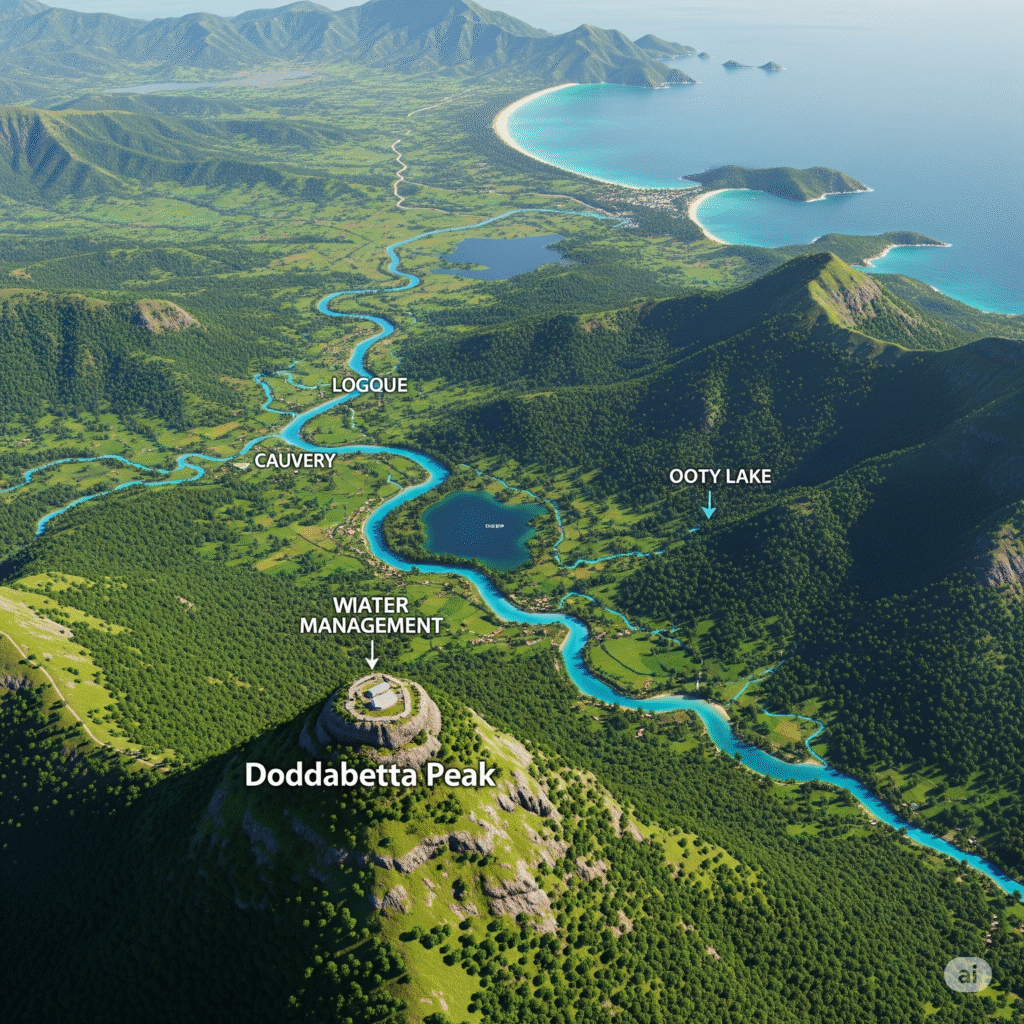
The history of Tamil Nadu is extremely rich and diverse , making it one of the most ancient and culturally important regions of India. The region has been a centre of civilisation , literature , art, and religion for thousands of years. The history of Tamil Nadu begins with the Dravidian civilisation and stretches through the ancient , medieval , and modern periods. Let us understand it in detail :
Ancient history
1. Dravidian civilization
- The history of Tamil Nadu is linked to the Dravidian civilisation , which was a contemporary of the Indus Valley civilisation such as Harappa and Mohenjo-daro.
- The Dravidian people are believed to be the original inhabitants of Tamil Nadu. Their culture and language ( Tamil ) have a history of 4,000-5,000 years.
- Sangam Age (300 BC – 300 AD ) :
- This was the golden age of Tamil literature , art , and culture.
- Three major Sangams ( literary gatherings ) were held , which produced Tamil literature such as the Tirukkural , Ettuttukkai , and Pattuppattu was composed.
- During the Sangam era, Tamil society flourished in the fields of agriculture , trade , and art.
2. Major ancient dynasties
Tamil Nadu was the centre of three major dynasties in ancient times :
( a ) Chola dynasty
- The Chola dynasty rose during the Sangam era and remained powerful from the 9th century to the 13th century.
- Major Rulers :
- Rajaraja Chola I : Built the Brihadeeswarar Temple in Thanjavur.
- Rajendra Chola : Expanded the Chola Empire in South – East Asia.
- The Chola Empire was famous for its architecture , maritime trade and administration.
( b ) Pandya dynasty
- The Pandya dynasty was established in the region around Madurai.
- were known for pearl production , maritime trade and literary contributions.
- Pandya rulers have made major contributions to Sangam literature.
( c ) Chera dynasty
- The Chera dynasty ruled over regions of western Tamil Nadu and Kerala.
- They were famous for their control over the spice trade and sea routes.
- Major Port : Muziris.
Medieval History (7th to 17th Century )
1. Pallavas dynasty (7th – 9th century )
- The Palava dynasty ruled from Kanchipuram in the northern part of Tamil Nadu.
- This dynasty was a patron of arts , architecture , and religion.
- The Rath Temple and Shore Temple of Mahabalipuram are wonderful examples of Palava architecture.
- He was a major supporter of Shaiva and Vaishnava religions.
2. Resurgence of the Chola Empire (9th – 13th century )
- During this period, the Chola Empire expanded to South India as well as Sri Lanka and South – East Asia.
- The Dravidian style of temple construction was at its peak during this period.
- The Chola administration and canal system are considered unique.
3. Rise of Pandya Empire (13th – 14th century )
- The Pandya empire reestablished its power during this period.
- Pandya rulers made significant contributions to art , culture , and trade.
- 14th century , the Delhi Sultanate weakened the Pandya kingdom by establishing the Madurai Sultanate.
Modern history (17th century to 20th century )
1. Vijayanagara Empire (14th – 17th century )
- Tamil Nadu became a part of the Vijayanagara Empire.
- This period was a time of religious and cultural renaissance.
- Religious places and temples were renovated.
2. Maratha and European influence (17th – 18th century )
- The Marathas and local rulers ruled parts of Tamil Nadu in the 17th century .
- The European powers arrived at this time :
- Dutch , Portuguese , French , and British .
- The British East India Company developed Madras ( Chennai ) as its major centre in the 18th century .
3. British Colonization (18th – 20th century )
- Tamil Nadu came under the British Empire.
- It was organised under British rule as the Madras Presidency.
- At this time the freedom struggle in India intensified. Many leaders of Tamil Nadu , such as :
- C. Rajagopalachari ( first Governor General of India ) .
- Subramanya Bharati ( famous poet and freedom fighter ) .
- Vo . Chidambaram Pillai ( pioneer of Swadeshi movement ) .
Post Independence (1947 to Present )
- 1956, the Madras Presidency was reorganised on a linguistic basis to form the state of Tamil Nadu.
- In 1969 , the state was renamed ” Tamil Nadu ” .
- Today , Tamil Nadu is a major cultural , industrial and economic centre.
Special historical contribution
Dravidian Movement :
- 20th century, Periyar and other leaders campaigned for social equality and a revival of Dravidian culture.
- Political parties like Dravidar Kazhagam and DMK are associated with this movement.
Temple Architecture :
- The temples of Tamil Nadu , such as the Brihadeeswarar Temple at Thanjavur , the Meenakshi Temple at Madurai , and the Nataraja Temple at Chidambaram , are its cultural heritage.
Tamil Literature :
- Tamil literature has enriched Indian literature from the Sangam age to modern times.
- Texts such as Tirukkural provide ethical and philosophical perspectives for humanity.
conclusion
has witnessed civilization , culture , and political upheaval . From ancient Dravidian culture to modern times, this state has played an important role in the development and culture of India. The contribution of its rulers , litterateurs , and artists makes Indian history and cultural heritage invaluable.
Language and Culture
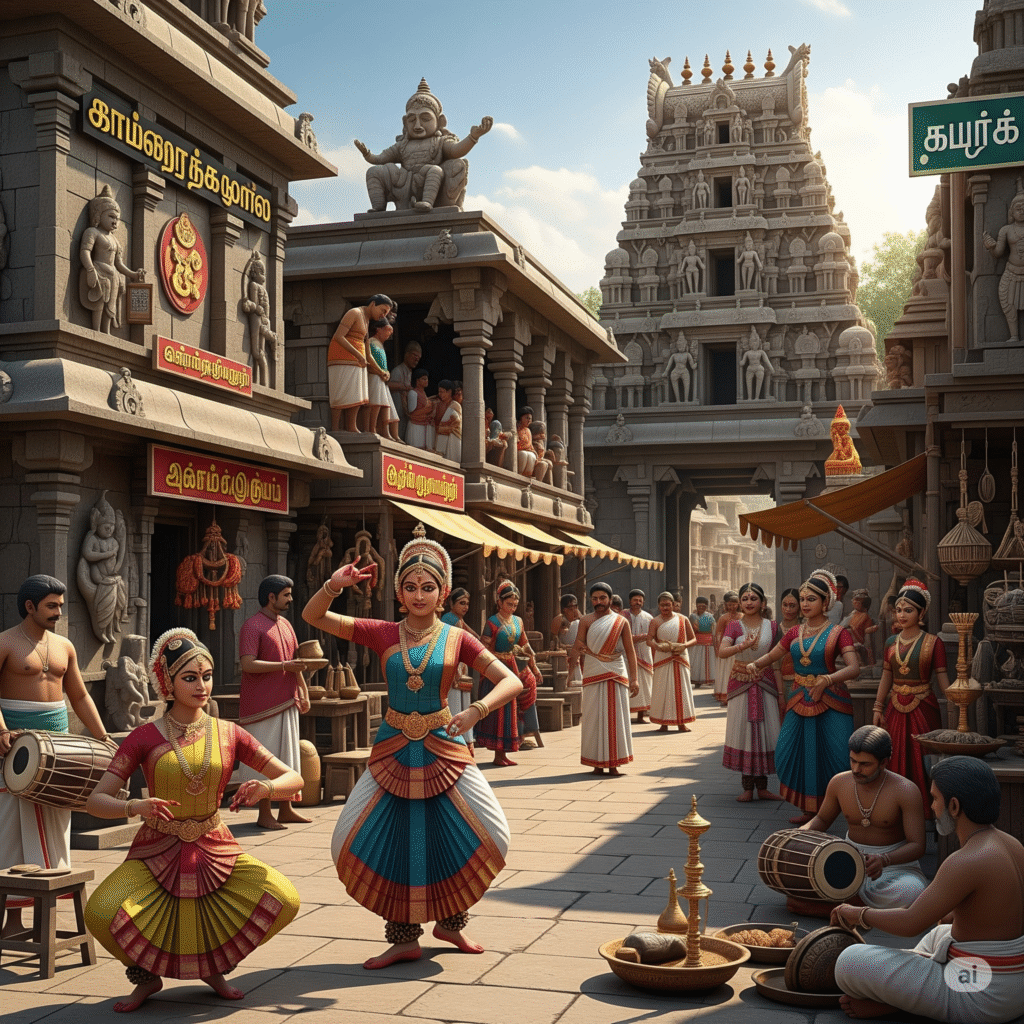
The language and culture of Tamil Nadu is its most precious and glorious aspect. The state is famous all over the world for its ancient language , rich traditions , and vibrant culture. Let us understand this in detail :
Language
1. Tamil language
- Tamil It is one of the major classical languages of India and is considered one of the most ancient languages in the world.
- The history of Tamil literature dates back more than 2,000 years.
- It is a Dravidian language family It is part of the and is spoken by approximately 8 crore people.
- The Tamil language was given ” classical language ” status by the Government of India in 2004 .
2. Tamil literature
- The golden age of Tamil literature is considered to be the Sangam age (300 BC – 300 AD ) .
- Major works :
- Tirukkural ( by Thiruvalluvar ): On ethics , religion , and rules of life.
- Silappadikaram and Manimekalai : the Tamil epic.
- Agananuru and Purananooru : part of Tamil Sangam poetry.
- devotional literature to Tamil literature , especially the Alvars ( Vaishnavite saints ) and Nayanars ( Shaivite saints ) poets, is unique.
3. Modern Tamil
- Tamil cinema and media have given new heights to modern Tamil literature and language.
- Tamil language is also being promoted through computers and Internet.
Culture
The culture of Tamil Nadu is a wonderful amalgamation of Indian traditions , in which music , dance , food , and customs have a special place.
1. Religion and religious traditions
- The religion and culture of Tamil Nadu are deeply intertwined.
- Shaivism and Vaishnavism These are the mainstays of the religious traditions here.
- There are hundreds of ancient temples in the state , such as :
- Meenakshi Temple ( Madurai ) .
- Brihadeeswarar Temple ( Thanjavur ) .
- Rameswaram Temple .
- Chidambaram Nataraja Temple .
- Ayyappa Puja , Murugan Puja , and Amman Puja Tamil Nadu has special religious traditions.
2. Arts and Performances
( a ) Dance
- Bharatanatyam :
- The most famous classical dance of Tamilnadu.
- This dance form is dedicated to Lord Shiva and is considered to be a coordination of ” meaning , music , and dance ” .
- This dance is famous for its expressions , postures , and storytelling.
( b ) Music
- Carnatic Music :
- Tamil Nadu is a major centre of Carnatic music.
- Tyagaraja , Muthuswami Dikshitar , and Syama Shastri are cultural icons of Tamil Nadu.
- Folk Music :
- Folk music and devotional songs have a prominent place in the rural areas of Tamil Nadu.
3. Festivals
The festivals of Tamil Nadu reflect the vibrancy of its culture :
- Pongal :
- The biggest and most important festival of Tamilnadu.
- It is celebrated after the harvest and lasts for four days.
- Diwali : Festival of Lights.
- Tamil New Year ( Puthandu ) : New Year according to the Tamil calendar.
- Karthigai Deepam : It is a festival of lights and devotion.
- Jallikattu : Traditional bull – riding sport held during Pongal .
- Navaratri : Tradition of decorative ‘ Golu ‘ during Goddess worship .
4. Architecture and sculpture
- Dravidian style architecture of Tamil Nadu It is world famous.
- The temple’s gopuram ( main gate ), huge courtyard , and statues are its main attractions.
- Rathas and Shore Temple of Mahabalipuram UNESCO World Heritage Site are included in.
- The Brihadeshwara Temple of Thanjavur is a wonderful example of Chola architecture.
5. Traditional Wear
- Men : Veshti ( dhoti ) is the traditional dress.
- Women : Kanchipuram Saree They wear , which is the identity of Tamilnadu.
- On special occasions , people wear traditional jewellery and gajra.
6. Food
- The food of Tamil Nadu is simple , tasty and nutritious.
- Main dishes :
- Sambar , rasam , idli , dosa , and vada .
- coconut , tamarind , and spices.
- Chettinad Cuisine : Famous for spicy and aromatic dishes.
- Pongal : Special dish made on festivals and special occasions.
7. Traditional Sports and Arts
- Jallikattu : Traditional bull – rearing sport.
- Kolam : Rangoli made in front of the house.
- Storytelling : Performance of religious and mythological stories.
8. Cinema and modern culture
- Tamil cinema , also known as Colywood It is said to be a major part of Tamil culture.
- Tamil films popularised literature , music , and art on a large scale.
- Actors like M. G. Ramachandran and Sivaji Ganesan and musicians like A. R. Rahman became globally famous.
conclusion
The language and culture of Tamil Nadu are its identity. The traditions here date back to ancient times and are alive even in the modern era. Tamil Nadu’s art , music , dance , festivals , and literature make it a unique cultural heritage. Its diversity and depth reflect the rich cultural tradition of India.
Economy of Tamil Nadu
The economy of Tamil Nadu is one of the most diversified and prosperous economies in India. The state is known for its balanced growth in the industrial , agricultural , service and trade sectors. Tamil Nadu ranks among the top states in India in terms of Gross State Domestic Product (GSDP) , and it contributes significantly to the country’s economic progress.
Let us understand the economy of Tamil Nadu in detail :
1. Total size and structure of the economy
- Gross State Domestic Product (GSDP) :
Tamil Nadu has a GSDP of over ₹20 lakh crore (2023-24) . The state ranks third in the Indian economy. - Growth rate :
The state’s average annual economic growth rate is over 8% . - Per capita income :
Per capita income of Tamil Nadu is higher than the national average. - The economy is contributed by three major sectors :
- Agriculture : about 12%
- Industry : around 32%
- Services sector : around 56%
2. Agriculture and allied sectors
Tamil Nadu’s agricultural sector plays an important role in its economy , although it constitutes a relatively small portion of the GSDP.
( a ) Major crops
- Paddy ( Rice ): Tamil Nadu is called the ” Rice Bowl ” .
- Sugarcane , millets , pulses , and oilseeds.
- Spices : Turmeric and cardamom.
- Horticulture : Bananas , mangoes , coconuts , and citrus.
( b ) Irrigation and water management
- The Kaveri River is the main water source for the state’s agriculture.
- Cauvery Delta It is called the ” Rice Bowl ” of Tamil Nadu .
- , dams , and reservoirs for irrigation .
( c ) Dairy and animal husbandry
- Tamil Nadu is one of the major milk producing states in India.
- Fisheries ( fish farming ) is the main source of income in coastal areas.
3. Industrial area
Tamil Nadu’s industrial sector is the backbone of its economy. The state is one of the industrial hubs of India.
( a ) Major Industries
Manufacturing ( construction industry ) :
- Tamil Nadu is a leader in automobile and auto component manufacturing.
- Chennai is called the ” Detroit of India ” .
- Major companies : Hyundai, Ford, Renault-Nissan, and Ashok Leyland .
Cotton and Textile Industry :
- Coimbatore is called the ” Manchester of South India ” .
- Tamil Nadu is the largest cotton producing and exporting state in India.
- Tiruppur is famous for textile industry.
Steel and Cement :
- Salem and Tiruchirappalli are major centres of steel production.
- The cement industry is important to the state’s construction sector.
Electronics & IT :
- Tamil Nadu is a leader in the manufacturing of electronics hardware.
- Presence of major companies like TCS , Infosys , and Wipro in Chennai.
Petrochemicals and Energy :
- Petrochemical industries in Nagapattinam and Mannar Basin.
- Koodankulam Nuclear Power Plant.
( b ) Special Economic Zones (SEZs)
- has several SEZs , which promote exports and industrial development.
- MRC Nagar and Sriperumbudur are major hubs for IT and electronics.
4. Service sector
The service sector is the largest part of Tamil Nadu’s economy.
( a ) Information Technology (IT)
- is one of the top IT hubs in India .
- Tamil Nadu has high exports of IT and BPO services.
- Rajiv Gandhi Software Tech Park.
( b ) Tourism
- Tamil Nadu is a major centre for tourism.
- Religious place : Meenakshi Temple , Rameswaram.
- Cultural places : Mahabalipuram , Thanjavur.
- Nature Spots : Ooty , Kodaikanal.
- Medical Tourism : Chennai is the hub of medical tourism in India.
( c ) Financial Services
- Chennai is called the ” Financial Capital of South India ” .
- High contribution in banking and insurance sector.
5. Trade and export
Tamil Nadu is one of the major exporting states of India.
( a ) Major export products
- Automobiles and their components.
- Clothing and apparel.
- Leather and leather products.
- Electronics and Machinery.
( b ) Ports and maritime trade
- 3 major ports in Tamil Nadu :
- Chennai , Tuticorin , and Ennore.
- These ports play an important role in India’s international trade.
6. Energy and Infrastructure
( a ) Energy production
- Tamil Nadu is a leader in electricity generation.
- Major contributors are nuclear , wind , and solar energy.
- Wind energy Tamil Nadu is a leader in wind power and is called the ” wind power hub of India ” .
( b ) Transportation and Logistics
- Road network : Tamil Nadu has the largest road network in India.
- Railways : Southern Railway headquarters is in Chennai.
- Airports :
- Chennai International Airport.
- Other airports like Coimbatore and Madurai.
7. Social and human development
( a ) Education and employment
- Tamil Nadu is a leader in education and has a literacy rate higher than the national average.
- Premier educational institutions like IIT Madras and NIT Trichy.
- Tamil Nadu is a major employment hub in India.
( b ) Health care
- Tamil Nadu is a leader in government and private health services.
- A hub of medical tourism due to its high quality healthcare services.
conclusion
Tamil Nadu’s economy exemplifies diversity and sustainability. The balanced contribution of agriculture , industry , and service sectors makes it India’s economic powerhouse. Its success in tourism , IT , and automobile industries makes it a model for other states. Tamil Nadu will make further progress in the coming years through its economic contributions and innovations.
Major City of Tamil
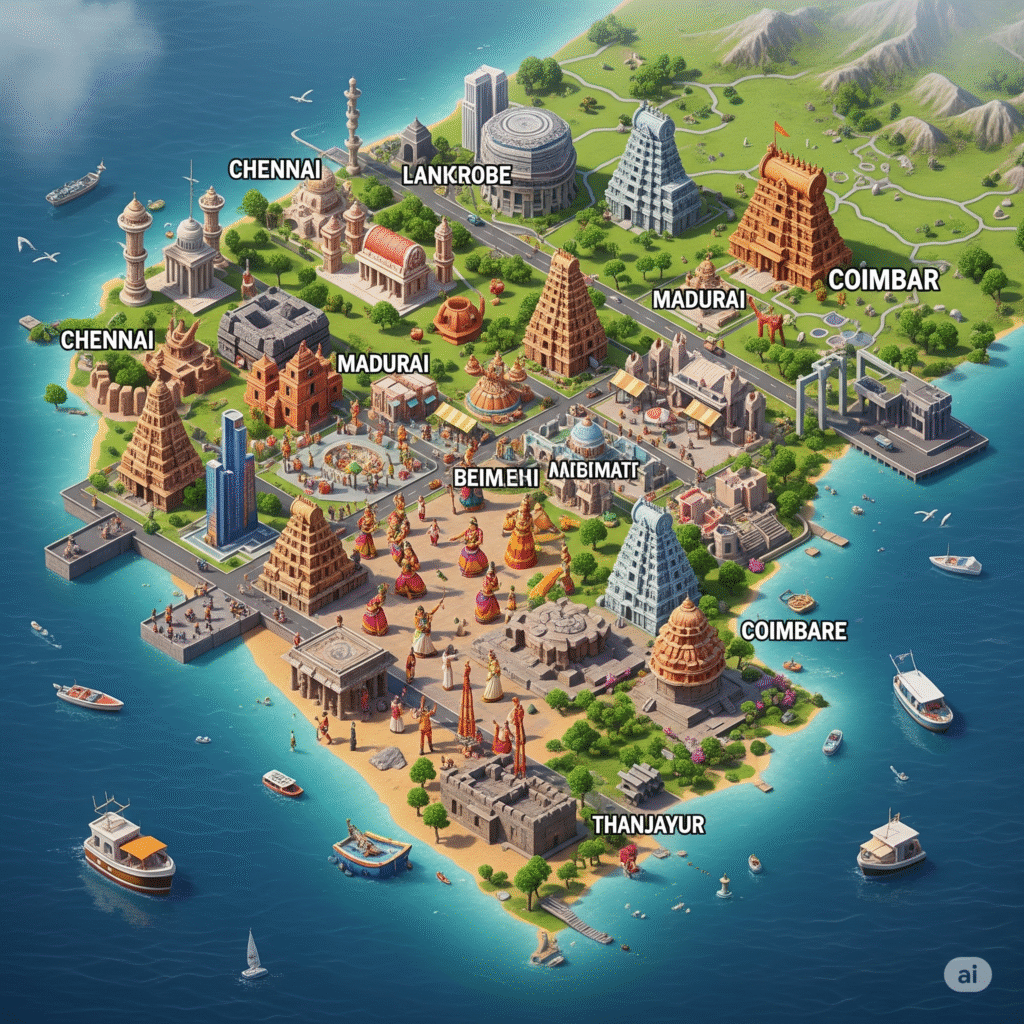
Tamil Nadu has many major cities , which are famous for their historical , cultural , economic and tourist importance. These cities reflect the diversity and rich tradition of the state. Here is a detailed description of the major cities of Tamil Nadu :
1. Chennai ( formerly Madras )
Introduction
- The capital of Tamil Nadu and the fourth largest metropolis in India.
- It is called ” Gateway to South India ” and ” Detroit of India ” .
features
- Economic Centre :
- Major hub of IT and BPO industry.
- Hub of automobile manufacturing.
- Tourism :
- Marina Beach ( Longest beach in India ) .
- Kapaleeswarar Temple and St. Thomas Basilica.
- Fort St. George.
- Education and Health :
- IIT Madras , Anna University.
- Famous for medical tourism.
- Culture :
- Centre for Carnatic Music and Bharatanatyam.
2. Coimbatore
Introduction
- Second largest city of Tamil Nadu.
- It is called the ” Manchester of South India ” .
features
- Industrial Centres :
- Famous for textile industry and cotton products.
- Electronics and machinery manufacturing.
- Education :
- PSG College and Amrita University.
- Tourism :
- Marudhamalai Temple.
- Valparai and Siruvani Falls.
- Health Care :
- Coimbatore is a major medical centre in South India.
3. Madurai
Introduction
- Third largest city of Tamil Nadu.
- It is called the ” city of temples ” .
features
- Religious significance :
- Meenakshi Amman Temple ( built by Pandya Dynasty ) .
- Alagar Kovil and Tiruparankundram.
- History :
- The main centre of Sangam era.
- The ancient plan of Madurai is considered in the form of a ” Lotus flower ” .
- Tourism :
- Gandhi Memorial Museum.
- Beautiful view along the Vaigai River.
4. Tiruchirappalli (Trichy)
Introduction
- It is also known as ” Trichy ” .
- It is a major religious and industrial center of Tamil Nadu.
features
- Religious places :
- Srirangam Temple ( dedicated to Lord Vishnu ) .
- Rockfort Temple.
- Industrial Contribution :
- Steel and engineering industries.
- Education :
- NIT Tiruchirappalli.
- Tourism :
- Beautiful views along the banks of river Cauvery.
5. Thanjavur
Introduction
- It is called the ” Heritage City of Tamil Nadu ” .
- It was a major cultural and political centre during the Chola dynasty.
features
- Religious and cultural places :
- Brihadeeshwara Temple ( UNESCO World Heritage Site ) .
- Saraswati Mahal Library.
- Art and Music :
- Thanjavur paintings and Thanjavur musical instruments.
- Agricultural Centre :
- Leading in agricultural productivity due to Cauvery delta.
6. Salem
Introduction
- Major industrial city of Tamil Nadu.
- It is situated near the Western Ghats.
features
- Industrial Centres :
- Steel Industry ( Salem Steel Plant ) .
- Textile and Handloom Industries.
- Tourism :
- Yercaud Hill Station.
- Kannanur Kilisagar Dam.
- Education :
- Vinayaka Mission University.
7. Tirunelveli
Introduction
- It is an ancient city of Tamil Nadu.
- Important centre of the Pandya dynasty.
features
- Religious places :
- Nellaiappar Temple.
- Kurtalam Falls.
- Agriculture :
- Sugarcane and paddy production.
- Tourism :
- Tamiraparani River and surrounding natural beauty.
8. Vellore
Introduction
- It is a major medical and educational centre of Tamil Nadu.
features
- Treatment :
- Christian Medical College (CMC), which is world renowned.
- Religious places :
- Golden Temple ( Golden Temple ) .
- Education :
- VIT University.
- Industrial Contribution :
- Leather industry.
9. Erode
Introduction
- It is called the ” Textile City ” .
features
- textile industry :
- Major handloom and powerloom centre of India.
- Agriculture :
- Leader in turmeric production.
- Tourism :
- Bhavanisagar Dam.
10. Rameswaram
Introduction
- It is one of the four Dhams of India.
- It is located on the Pamban Island.
features
- Religious significance :
- Ramanathaswamy Temple.
- Historical importance of Dhanushkodi.
- Tourism :
- Pamban Bridge.
- Marine biodiversity.
conclusion
The major cities of Tamil Nadu reflect the diversity , cultural heritage and economic prosperity of the state. Each city holds a special place for its history , culture , and economic contribution. The balanced development of these cities is the basis of the progress of Tamil Nadu.
Tourism of Tamil Nadu
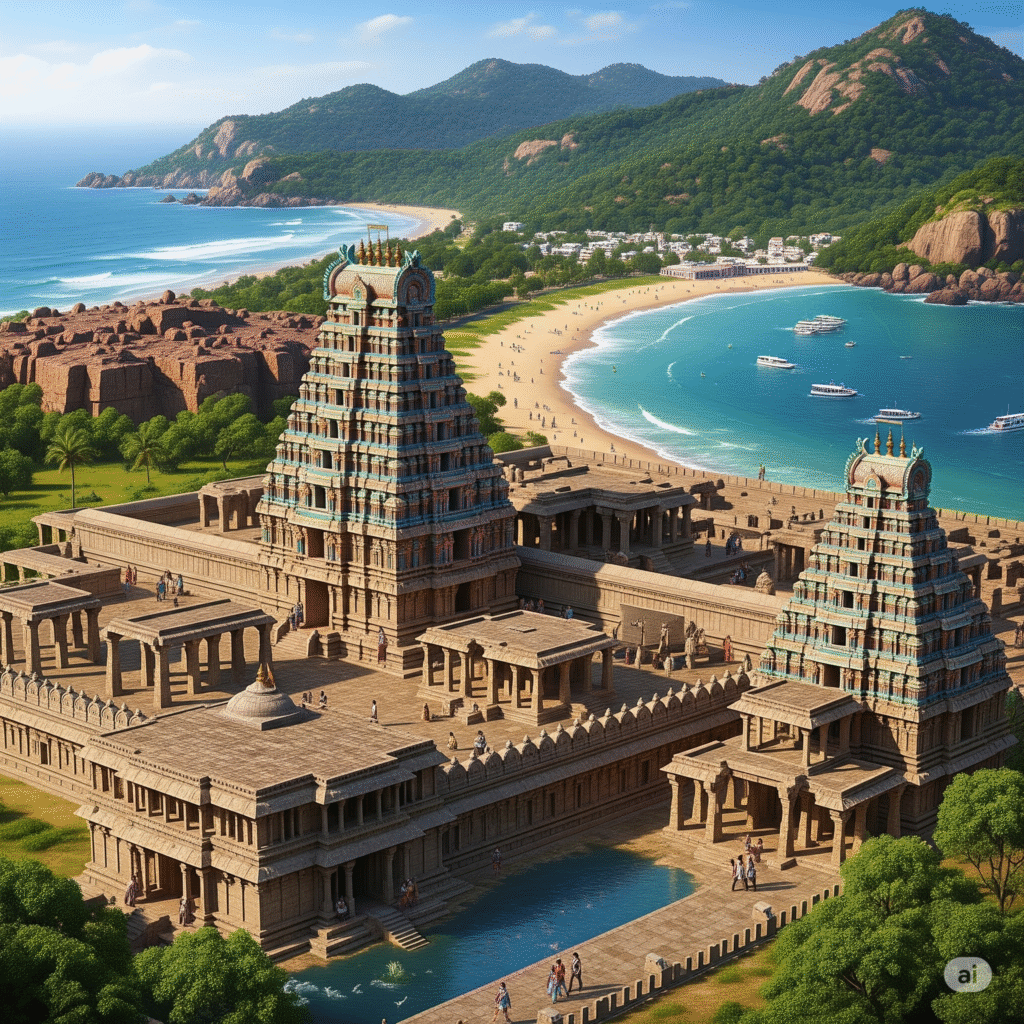
Tamil Nadu tourism is a wonderful blend of historical , cultural , religious and natural beauty. The state is famous for unique temples , ancient monuments , beaches and hill stations. Here is a detailed description of the major destinations :
1. Meenakshi Temple , Madurai
Introduction
- is dedicated to Goddess Meenakshi ( Parvati ) and Lord Sundareswarar ( Shiva ) .
- The focal point of Madurai city and one of the most famous temples in India.
features
- architecture :
- The temple is built in Dravidian style.
- 14 magnificent gopurams ( gateway towers ), carved with thousands of sculptures.
- The ” Aayiram Kalai Mandapam ” ( Pavilion of the Thousand Pillars ) is a major attraction.
- Religious significance :
- This temple symbolizes the ancient religious and cultural traditions of Tamil Nadu.
- ” Meenakshi Tirukalyanam ” festival is celebrated every year in the temple .
- Tourism :
- The place attracts pilgrims and tourists alike.
2. Group of Monuments at Mahabalipuram
Introduction
- Mahabalipuram ( also known as Mamallapuram ) is a historical site located south of Chennai.
- It is a UNESCO World Heritage Site and was built during the Pallava dynasty (7th – 8th century ) .
features
- Major monuments :
- Pancha Rathas : Chariot – shaped monuments made of five stones .
- Shore Temple : A unique temple built on the seashore.
- Arjuna’s Penance : Paintings carved on a huge rock , depicting mythological stories.
- Krishna’s Makkhan Gola : A huge round stone standing on balance.
- Artistry :
- The group of monuments houses amazing rock cut sculptures and caves.
- Tourism :
- Beaches and historical sites attract tourists.
3. Kanyakumari
Introduction
- It is a city located at the southernmost tip of India.
- This place is famous for the confluence of the Indian Ocean , Bay of Bengal and the Arabian Sea.
features
- Religious significance :
- Kanyakumari Devi Temple.
- Goddess Parvati is believed to have performed penance here.
- Natural beauty :
- Beautiful views of sunset and sunrise.
- Main attractions :
- Vivekananda Rock Memorial : Memorial situated on a rock in the sea.
- Thiruvalluvar Statue : 133 feet high statue of Tamil poet and philosopher Thiruvalluvar .
- Gandhi Mandapam : A memorial built to commemorate the ashes of Mahatma Gandhi.
- Tourism :
- Every year millions of tourists come here due to its confluence with the sea and its cultural importance.
4. Hill stations of Ooty and Kodaikanal
( a ) Ooty ( Udhagamandalam )
Introduction
- It is called ” Queen of Nilgiri ” .
- This hill station is situated in the Nilgiri Hills of the Western Ghats.
features
- Natural beauty :
- Surrounded by tea plantations , lush forests , and tranquil lakes .
- Main attractions :
- Ooty Lake.
- Doddabetta Peak ( the highest peak in Nilgiris ) .
- Botanical Garden.
- Nilgiri Mountain Railway ( UNESCO World Heritage Site ) .
- Tourism :
- It is famous as a honeymoon destination.
( b ) Kodaikanal
Introduction
- It is called ” Princess of the Mountains ” .
- It is a beautiful hill station located in the Palayam Hills.
features
- Natural beauty :
- Tranquil lakes , beautiful valleys , and waterfalls.
- Main attractions :
- Kodai Lake.
- Pillar Rocks.
- Silver Cascade Waterfall.
- Bryant Park.
- climate :
- The weather here remains pleasant throughout the year.
5. Rameswaram
Introduction
- It is one of the four Dhams of Hinduism.
- According to Ramayana , Lord Rama built ” Ram Sethu ” ( Adam’s Bridge ) to go to Lanka from here.
features
- Religious significance :
- Ramanathaswamy Temple , dedicated to Lord Shiva.
- The temple has 22 theerthakundas ( sacred water tanks ) .
- Main attractions :
- Pamban Bridge , which connects Rameswaram to the mainland.
- Dhanushkodi : According to Ramayana , this is the place where Ram Sethu was built.
- Ram Padam : Represents the footprints of Lord Rama.
- Tourism :
- The site is attractive to both pilgrims and history lovers.
conclusion
These places in Tamil Nadu attract tourists due to their historical , religious , and natural significance. Cultural centers like the Meenakshi Temple and Mahabalipuram , the sea confluence of Kanyakumari , the cool valleys of Ooty and Kodaikanal , and the spiritual significance of Rameswaram make this state unique. Tamil Nadu offers something for every type of tourist to visit.
Reference
Official website of Tamil Nadu Government: https://www.tn.gov.in
Tamil Nadu Tourism Department: https://www.tamilnadutourism.tn.gov.in
Geography of India and state-wise information (NCERT – Geography and History books, especially class 6–12)
India Year Book (Bharat Varshpustaka), Publications Division, Government of India
Publications of Rajya Sabha/Lok Sabha Secretariat
Encyclopaedia Britannica: Detailed article on Tamil Nadu
UNESCO World Heritage Centre (Information about places like Mahabalipuram)
World Atlas / CIA World Factbook – Geography and statistics of the state
